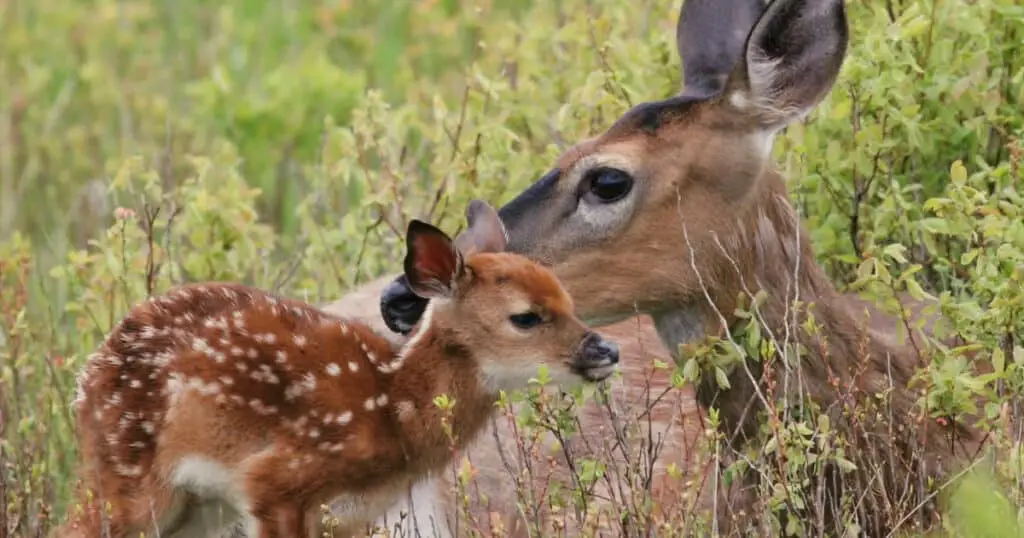Each spring, deer populations get a brief spike as the changing season brings the birth of fawns. Both the characteristics and behavior patterns of fawns are remarkably similar across species. That said, there can be differences in parenting techniques between different types of deer. Some of these differences lies in how deer care for their fawns in the early days and how long do fawns stay with their mother.
Using the white-tailed deer as a template for general fawn behavior makes sense. In this article, we will discuss the early life of the fawn, including its birth, survival, and how long fawns stays with their mother.
What You May Observe (and why)
Table of Contents
ToggleIf you head into the wild during spring and summer, seeing a larger fawn with their mom is a common site.
It’s also not uncommon to stumble upon young fawns hiding in brush, although they are extremely hard to spot thanks to camouflage. They even manage to evade dogs and predators by masking their smell.
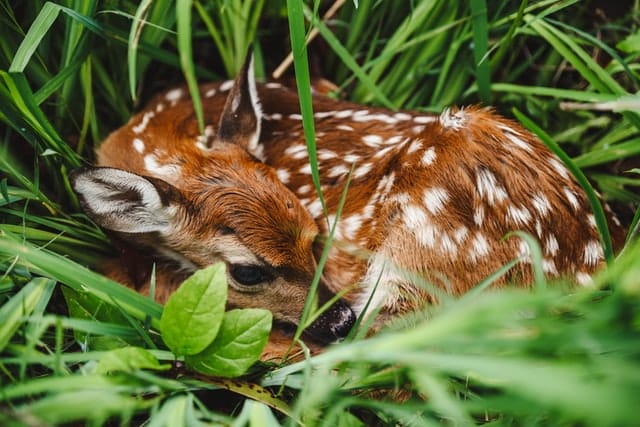
But if you do stumble upon a fawn by itself don’t be alarmed – it’s common for deer to hide their fawns and leave them alone for long stretches while the fawns gain the strength needed to run from predators.
Being able to hide in plain sight is one of the best natural tools deer have at their disposal. For fawns, this ability becomes its most fundamental survival technique.
Like most baby mammals, fawns are born incredibly weak compared to adults. Making it through the early stages of life is the biggest challenge, and their natural camouflage and ability to conceal themselves is key to their survival.
Preparing for Birth
Mating season for most deer occurs between October and early December.
Firstly, a mother doe will drive off any male offspring from the previous year. Male deer don’t have any issues with attempting to mate with their own mother, so the doe takes no chances.
Females from the previous year will often stay with their mother and whitetail deer can form large maternal family groups. Whitetails are uniparental, so the male father will not be present during the birth or the caregiving for the offspring.
The gestation period of deer varies across different deer species, but for whitetails, after seven months gestation, the doe prepares to give birth.
When the doe is nearing the final stages of pregnancy, she selects a birthing area. This is not just any place, but rather a carefully selected location that will conceal her while giving birth and protect the newborn fawn. Mothers typically look for well-vegetated areas but have also been known to select dry ponds.
How Long do Fawns Stay with Their Mother?
So how long do fawns stay with their mother after they are born? At what age do they become independent and strike out on their own? Will they remain a part of their mother’s herd?
We’ll walk you through all of this information here.
Fawns at Birth
There is a common misconception that deer give birth to a single offspring each year, but that is not always the case. For example, whitetails can give birth to up to four fawns. Between one and three is the most common number of fawns born to a single white tailed doe.
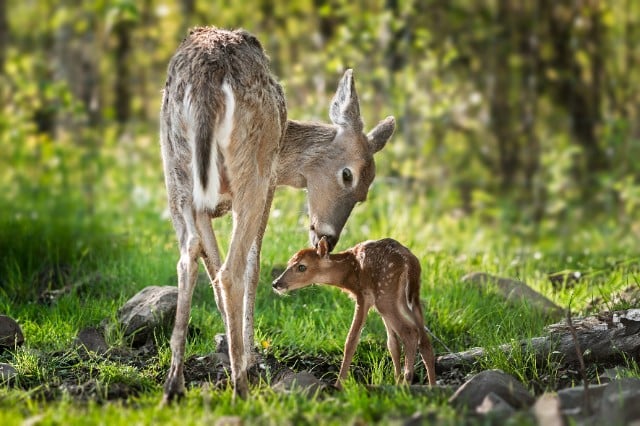
Typically, larger deer species tend to have fewer offspring. For example large Red Deer will generally have a single fawn,
Interestingly, whitetail deer seem to have built-in understanding of when to have multi-fawn births and not. It’s important to remember that the goal is to extend lineage and maintain the balance of the species. Of course, the deer does not understand this, but instead has the guiding hand of Mother Nature.
During bad years, a deer may not breed or have only a single fawn. During good years where forage is plentiful and she is healthy and well-fed during the rut, the doe will drop more eggs and may have two or more.
Twins are the most common for whitetails, but it is worth noting that most baby whitetails don’t make it to maturity.
When ready, the doe takes anywhere from a few minutes to a few hours to give birth. Once born, fawns weigh around 8 pounds and are largely helpless directly after birth.
The mother’s role during this time is to help get the fawn standing, walking, and moving. Fluids and blood around the birthing site are a big attraction to predators and a helpless fawn can make an enticing and easy meal.
It usually takes the fawn, with plenty of cajoling from the doe, around an hour to stand and take steps. When ready, the doe will lead the fawn to a more sheltered location known as a form. If there are multiple fawns, the mother will often keep them in separate forms that are close to each other. This way if a predator finds and kills one fawn, the other may survive.
Early Life
Fawns are born with a reddish brown coat that has sporadic white spots. It is an ideal camouflage that makes them nearly invisible to predators.
Any hiker who has ever stumbled upon a fawn in their form will know how hard these baby animals are to see. They also have minimal scent and dogs can often walk straight by a fawn without knowing it is there.
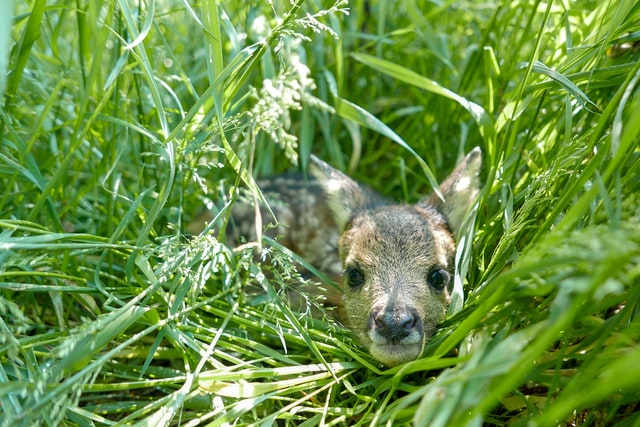
This is another reason why the doe is not constantly around the fawn … she wants to avoid contaminating the form with her scent.
One mistake hunters and hikers make is finding a fawn in its form and assuming it has lost its mother or has been abandoned. This is exceedingly rare and the best thing to do if you stumble upon a fawn is to move away slowly.
Sometimes a baby deer may follow you. If this happens, gently place pressure on its shoulders to ease it into a lying down position and leave.
A Fawn’s First Month
Over the first month of its life, the fawn will remain in the form waiting for its gangly long legs to become strong enough to run. While it can stand and walk at this age, it is not yet powerful enough to keep up with its mother, or to flee from predators.
One of the instinctual gifts fawns have is the ability to stay quiet during the first three weeks of its life. After around a month, fawn legs are strong enough to support running. Now able to keep up with the doe, the fawn is ready to leave the protection of the form and learn from its parent how to forage for food.
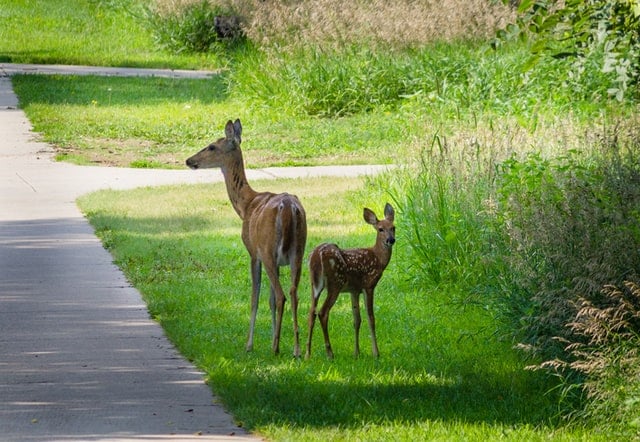
During this learning phase, the mother will continue to nurse the fawn. However, fawn are remarkably quick at adapting their food gathering skills. They quickly transition to an adult diet of grasses, tree leaves, beans, acorns, bark, wild fruit, and so on.
Becoming Independent
White-tailed deer continue to be considered fawns until they are a year old, but this age can differ between deer species.
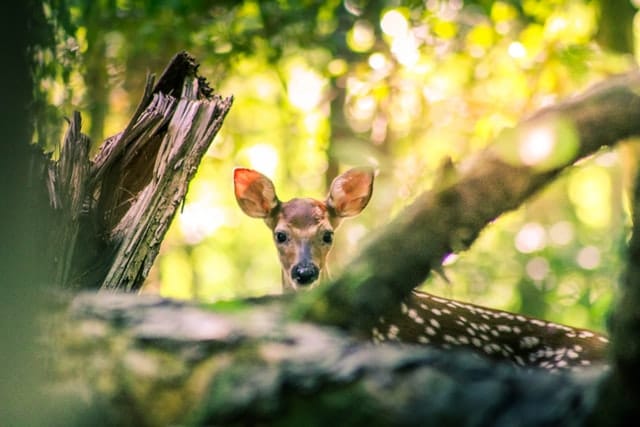
Once they reach this age, the fawn is then considered a yearling. During this young age, the fawn is at the greatest risk from predators.
Animals like coyotes, wolves, bobcats, mountain lions, and bears will all choose a whitetail fawn as a relatively easy meal. In fact, the fawn and yearling stage sees up to 40% mortality.
During the second year, the doe fawns (females) and the buck fawns (males) will take different paths. This includes how long fawns stay with their mother.
As mentioned, male offspring will be driven off by the mother before the mating season to avoid inbreeding. Females can stay for longer, either forming a family group or leaving the mother after two years.

